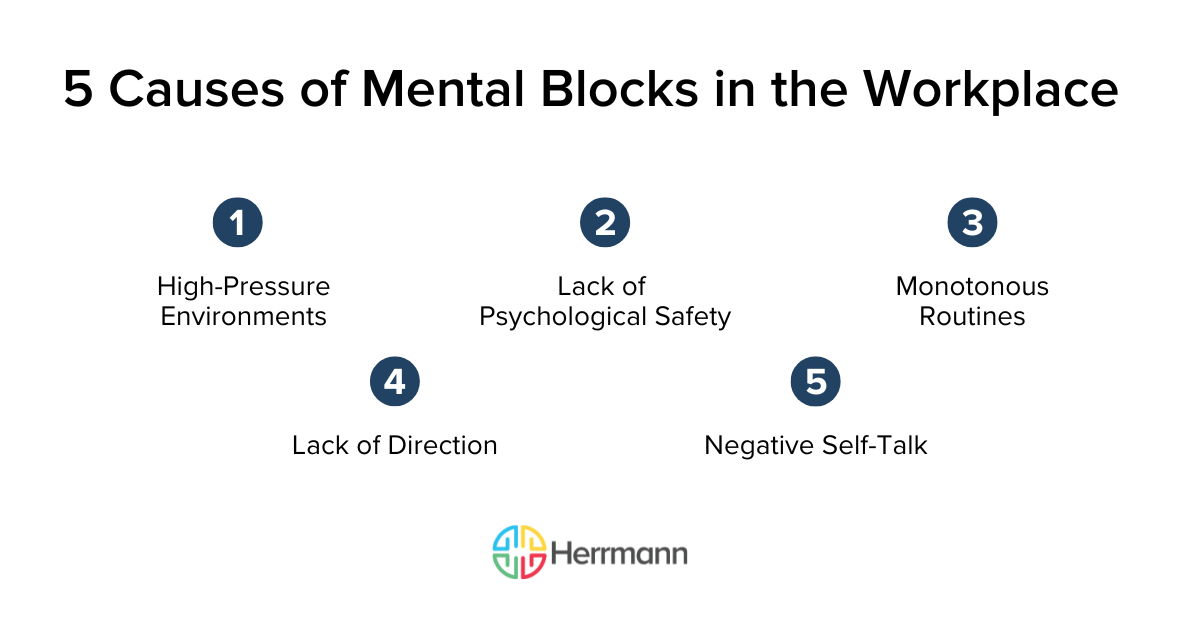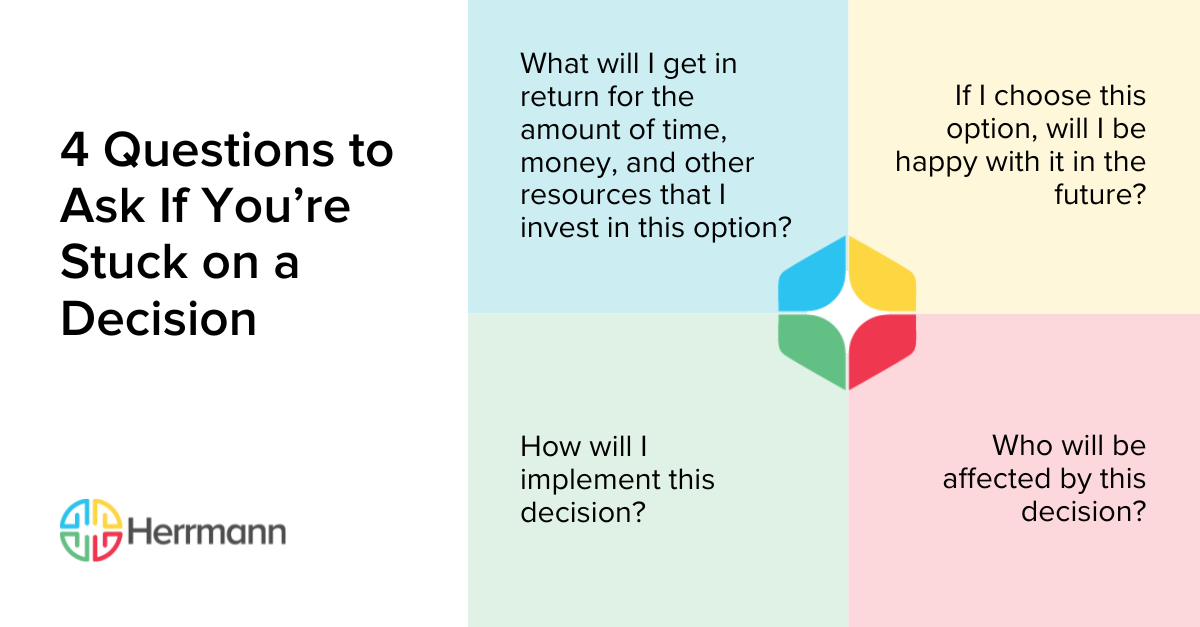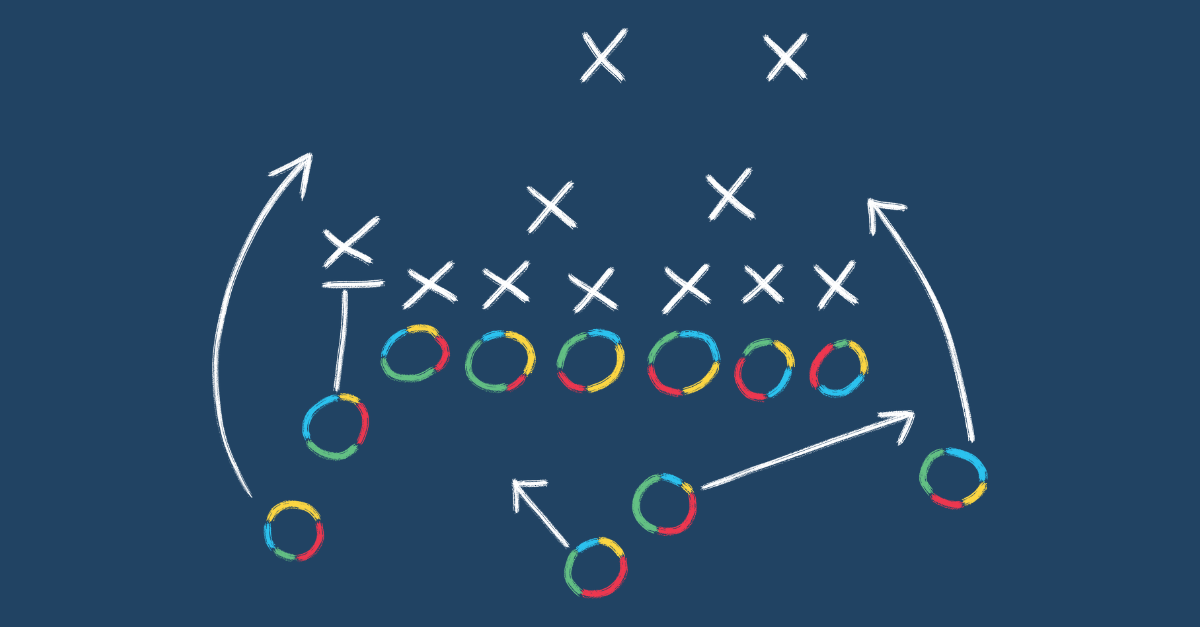What is a mental block? It’s that feeling we’ve all had when progress is difficult or nonexistent. Maybe you’re unsure where to go next or even how to start. Perhaps you’re struggling to focus or get back in gear. These mental blocks can be frustrating and hinder our productivity, creativity, and overall success.
Almost everyone (96%) has experienced mental blocks at work, according to a survey by Miro, and 1 in 6 workers suffers from them every day. And while everyone has bad days, regularly feeling stuck and unable to move forward is bad for your productivity, job satisfaction, and mental health. This has real costs for businesses and employees alike regarding procrastination, missed deadlines, reduced output, and higher turnover.
Learn more about what mental blocks are, how they manifest, and the adverse effects they can have on individuals, teams, and organizations when they go unchecked. You’ll also learn how to overcome mental blocks and how Whole Brain® Thinking can help.
What Are Mental Blocks?
Mental blocks are psychological barriers that prevent us from thinking clearly, making decisions, or taking action. They can arise from various causes, such as fear, self-doubt, perfectionism, and lack of motivation. When we encounter a mental block, our thoughts become stagnant, and we struggle to find innovative solutions or make progress.
Mental blocks can manifest as a sense of being stuck or unable to move forward, as if our thoughts are trapped in a loop. We may find ourselves lacking inspiration or creativity, unable to break free from repetitive thinking patterns. Mental blocks also can lead to self-doubt, as we hesitate to act or second-guess our decisions.
What Causes Mental Blocks in the Workplace?
There are many reasons people struggle with psychological blocks or the sense of feeling stuck. Here are some common factors you’ll encounter in the workplace.
High-Pressure Environments
Excessive stress, tight deadlines, and demanding workloads can create a breeding ground for mental blocks. The fear of failure or making mistakes can freeze people’s ability to make decisions or think creatively.
Perfectionism and burnout are additional drawbacks of high-pressure environments, and they contribute to mental blocks. The pressure to constantly perform at a high level can lead to a heightened sense of self-criticism and self-doubt. Physical or mental exhaustion is another factor — we struggle to make effective decisions when we’re fatigued or overworked.
Lack of Psychological Safety
When employees feel unsafe or judged in their work environment, they may hesitate to express their ideas or take risks. This fear of criticism or rejection can lead to mental blocks and a reluctance to think outside the box.
Google's research famously found that psychological safety was the No. 1 factor influencing team effectiveness. At Herrmann, our Whole Brain® Thinking framework emphasizes engaging with and embracing people’s different thinking styles. Only when people feel safe sharing themselves can teams collectively overcome mental blocks and solve problems.
Monotonous Routines
Engaging in repetitive tasks or following rigid processes for extended periods can stifle creativity and contribute to mental blocks. The lack of novelty and stimulation can make it challenging to generate fresh ideas or approach problems from different angles. Think of assembly line work — vitally important, but not the stage of the process where new ideas are sought.
Lack of Direction
Sign up to our newsletter for the latest insights
Negative Self-Talk
Negative self-talk, such as self-doubt or imposter syndrome, can create mental barriers. When people constantly question their abilities or undermine their own ideas, it becomes difficult to break free from self-imposed limitations.
Negative Impacts of Workplace Mental Blocks
When employees routinely suffer from mental blocks and don’t feel they have the tools to overcome them, their work and morale can suffer. Likewise, teams and organizations that regularly feel stuck will struggle to meet deadlines and goals, much less unleash the group's full potential. Here are some common negative consequences of unchecked mental blocks.
Decreased Productivity
When people experience mental blocks, they can struggle to focus and complete tasks efficiently or effectively — particularly creative tasks. Writer’s block is perhaps the most commonly known example.
These people can struggle to generate ideas, find solutions, or make progress on projects. This can lead to delays, missed deadlines, and a decrease in overall productivity.
Mental blocks can also contribute to poor time management, as your employees spend too much time on tasks and then struggle to catch up — adding stress that compounds the problem.
Procrastination
Mental blocks often contribute to procrastination. When people feel stuck or overwhelmed, they may delay taking action or making decisions. Procrastination can further exacerbate the mental block, creating a cycle of inaction and missed opportunities.
If you catch yourself in this cycle, try asking yourself these five questions to stop procrastinating. Going through that process can help you diagnose why you’re suffering from mental blocks.
Decline in Employee Morale and Retention
Persistent mental blocks can lead to frustration, self-doubt, and a decline in employee morale. This can have long-term effects on engagement and retention — and spread to the entire team.
Employees who consistently experience mental blocks may become demotivated. They can feel overwhelmed and blame themselves or others for the problem, harming team morale and camaraderie.
Stunted Innovation and Collaboration
Mental blocks hinder the ability to think creatively and collaborate effectively. This can hurt individual, team, and organizational innovation because people aren’t able to contribute their best thinking, ideas, and feedback.
Mental blocks can also prevent employees from recognizing opportunities or identifying alternative approaches, causing them to miss out on growth or competitive advantages. These missed opportunities can be detrimental to the organization and the person’s career.
Suboptimal Business Outcomes
The cumulative effect of mental blocks can significantly impact overall business outcomes. Decreased productivity, missed opportunities, hindered innovation, and strained collaboration can result in decreased revenue, customer dissatisfaction, and a decline in market competitiveness.
Organizations that fail to address and overcome mental blocks may fall behind their competitors.
.jpeg?width=700&height=648&name=Asset%203%20Large%20(1).jpeg)
Overcoming Mental Blocks With Whole Brain® Thinking
While you can work through a mental block, it’s not so simple as powering ahead. You need an approach that alleviates the causes and helps you build better habits and routines. One such approach is Whole Brain® Thinking — a framework based on the Herrmann Brain Dominance Instrument® (HBDI®) that helps individuals and teams understand their thinking preferences and leverage the full potential of their cognitive abilities.
Whole Brain® Thinking is based on the concept that everyone has different thinking styles and preferences. Individuals, pairs, teams, and organizations can improve their communication, collaboration, thinking, and decision-making by recognizing and using these preferences.
The framework is divided into four quadrants, each representing a different mode of thinking:
- Analytical (Blue): This quadrant is associated with logical and systematic thinking. People who prefer this thinking style tend to be analytical, detail-oriented, and focused on facts and data.
- Practical (Green): This quadrant is characterized by structured and organized thinking. People who prefer this quadrant are pragmatic, methodical, and focused on planning and implementation.
- Relational (Red): This quadrant is associated with interpersonal and emotional thinking. People who prefer this quadrant are expressive, empathetic, and seek out relationships and collaboration.
- Experimental (Yellow): This quadrant is associated with people who excel at generating innovative solutions, thinking outside the box, and envisioning the big picture.
People have capacity and potential in each quadrant, and they may have a strong preference for more than one. There's no right or wrong combination of thinking style preferences.
Here are several ways to overcome mental blocks in the context of Whole Brain® Thinking.
Recognize and Acknowledge the Mental Block
The first step in overcoming a mental block is acknowledging its presence. Be aware of the thoughts and emotions holding you back.
Depending on your thinking style preference, you might approach this step differently. Analytical (Blue) thinkers might prefer to map out their mental blocks — causes, factors, and potential solutions. Practical (Green) thinkers might find comfort in this being a known problem with known solutions. They can make a plan.
Relational (Red) thinkers might want to communicate their challenge and find comfort and ideas in communicating with their co-workers, family, or friends. Experimental (Yellow) thinkers might be down for the latest science and growth hacks related to productivity and creativity. These, of course, are just broad strokes of each thinking style preference and are not representative of how you or your co-workers will respond to feeling stuck.
Engage in Self-Reflection and Self-Awareness
Do you get up in the morning and immediately look at your phone or your to-do list? This can leave you overwhelmed almost immediately. One result is that you skim off the top of the pile, dealing with only the most recent and urgent items. Your day is spent reacting rather than making logical choices. You struggle to focus on creativity or the bigger picture because you’re mentally blocked from the get-go.
Pause and reflect on all these inputs — your emails, to-dos, meetings, and deadlines. For each new one that comes in, ask:
- Can I do something about this? This Analytical (Blue) approach is easy to forget. Not everything requires action, and you don’t always have to hit “reply.” Only some of your inputs call for follow-up; the rest can be filed away for future reference (or deleted).
- Should I do it right now — or at all? Be a Practical (Green) planner for a moment. If the follow-up action takes just a few minutes, consider doing it immediately. But if not, move on or set a reminder with a deadline. While you’re at it, maintain a not-to-do list. For example, review your calendar for the past month and reflect on your activities. Which of them can you stop doing to free up your calendar, stress, and mind?
- Which decisions will bring me personal and professional value? This Relational (Red) question gets at the heart of your work priorities, yes — what you must do to stay employed — but also what brings you fulfillment, growth, and joy.
- What did I learn today? As you wrap up your work day, explore this Experimental (Yellow) question. Don’t just grade yourself on a pass/fail of what you got done, but also look at what you learned, how you navigated obstacles, how you reoriented yourself to think differently when you felt stuck. And, perhaps most importantly, now that you’re unstuck: What will you do differently tomorrow?
Seek Support and Feedback
There’s nothing wrong with having a mental block. It’s not a sign of failure or weakness. It’s part of the human condition. You have the ability and agency to overcome mental blocks given the right tools and support.
To that end, you don’t have to go it alone. Don't hesitate to reach out to colleagues, mentors, or coaches for support and guidance. They can provide fresh perspectives, offer advice, and help you navigate your mental blocks.
Change Up Your Routines
Break free from your usual routines and explore new approaches to problem-solving. Experiment with different techniques, brainstorming methods, or creative exercises to stimulate fresh thinking.
This can be a very Yellow exercise, but that’s not the only way to approach it. You can get excited about the potential ROI of learning new things or trying different methods. You can map out a plan — creating a new routine out of disrupting your routine. And you can embrace the opportunity to have different conversations and engage with people in new ways.
Changing your routine can also involve changing the stressors that contribute to or worsen these mental blocks. That might require a change in mindset, rethinking your professional development plan or even changing employment — especially if unrelenting pressure and a lack of psychological safety can’t be addressed.
Reassess Your Goals and Expectations
Sometimes, mental blocks arise from setting unrealistic goals or putting too much pressure on ourselves. Set achievable goals and establish realistic expectations to alleviate unnecessary stress and self-imposed limitations.
And if you’re struggling to set goals or prioritize them, consider these four Whole Brain® Thinking-inspired questions:
- What will I get in return for the amount of time, money, and other resources that I invest in this option? (Blue)
- How will I implement this decision? (Green)
- Who will be affected by this decision? (Red)
- If I choose this option, will I be happy with it in the future? (Yellow)

Understand Mental Blocks So You Can Overcome Them
Suffering from a mental block is frustrating and can be detrimental to employee morale, team performance, and the ability to generate new ideas and business results.
Fortunately, while we’re all prone to suffering from this sense of feeling stuck, we’re not alone and helpless. When you understand what’s causing you to feel stuck and how Whole Brain® Thinking works, you’ll know how to overcome mental blocks, reduce your stress, and be your best self for your team and organization.
If your team feels stuck, download our WalkAround to ensure a cognitively diverse approach.


.png?width=1200&name=Featured_Image_What%20Is%20a%20Mental%20Block%205%20Tips%20for%20Overcoming%20Them%20(1).png)









